We had managed to sweet talk two of the crew on Arielle into taking us diving on Klein Bonaire, which is supposed to have the best diving of all in Bonaire. We have been wanting to go, but the wind and swell are way too strong for our little 2 horsepower dinghy motor to handle. First thing this morning, they picked us up in their powerful rib and we set off. It was actually a fairly long (and bumpy) ride. We went to a site on the west side of the little island called Sharon’s Serenity. One of the crew Mike, was diving, the other, Jack, was snorkeling.
Sadly, Jack said that it isn’t a very good snorkeling site. In all honesty, while Bonaire may be a diver’s paradise, it isn’t a great destination for snorkelers. The reefs aren’t really shallow enough for snorkeling. However, the dive was excellent. We are pleased to report that Mike has a dive camera and that he managed to get some phenomenal photos. The following pictures are all compliments of him.
The first shot is of Christi shortly after we descended, higher up on the reef. We like this picture because you can see the little gray chromium fish that are everywhere on Bonaire dives, and you get a good idea of what the landscape of the reef is like. Note the neat soft corals to the right. They really do look like they could be terrestrial plants.
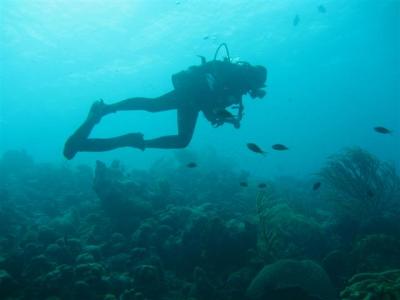
As we were making our way down, we had a huge school of Creole wrasse go flying by below us in a tube formation. It was a long tube made up of lots of fish! They are really neat looking, kind of blueish-purple with some yellow on their sides. We saw many more throughout the dive, too. We have generally seen some on every dive we have done in Bonaire, but never in such huge numbers.

Here is a horse eyed trevally. We also saw a lot of yellow jacks, which are similar looking. We haven’t seen very many jacks/trevally closer in to the mainland, but we saw several here. They tend to prefer outer reefs. They look like a tasty dinner!

There were a lot of surgeonfish around. And we mean a lot, especially a black variety with blue trim. We couldn’t find that specific variety in either of our fish books. Smack in the middle of this school of surgeonfish is a trumpetfish. To the right is a scrawled filefish. The filefish is pretty darn cool looking. The coral in the upper left corner is called plate cactus coral.
FI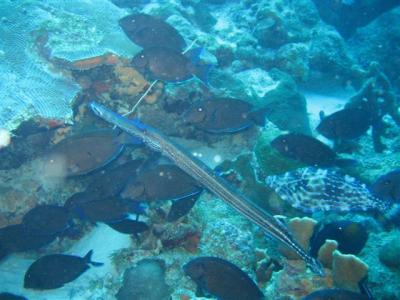
This is an orange elephant ear sponge with a little damselfish.
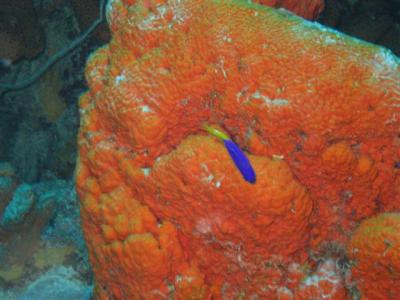
This is a honeycomb cowfish, which we mentioned seeing the first day we went diving in Bonaire. It is similar in shape to trunkfish we mention all the time, except trunkfish are black and white spotted and smaller in size. And we did see lots of trunkfish here. Note the white, light brown and olive lines in the picture. We are not sure of exactly sure what it is, but we think it is a soft coral. It looks just like really long strands of pipe cleaners. We have mentioned seeing it a few places in the world.
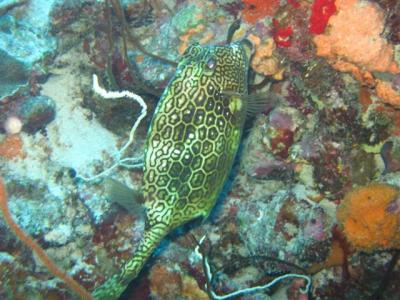
In the center of the photo is a tube sponge, which usually comes in yellow or purple. Sadly, in photography, the deeper you go, the more color you lose, which is why the pictures look so gray. To the left is smooth flower coral, which we see a lot of here in Bonaire.
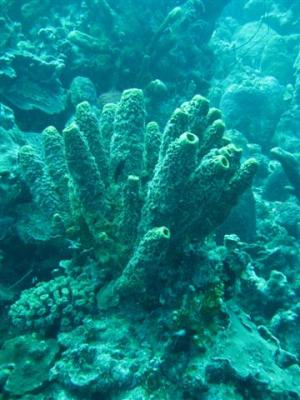
In addition to the species photographed above, we saw lots more cool stuff. The highlight was seeing two frogfish, side by side. They look like rocks and are very hard to spot in the wild, so we’re patting ourselves on the back for finding them. We also saw a large peacock flounder, another hard to spot species. There were a couple of snake eels slithering around, too.
In more obvious species, there are a lot of black durgeons around, which are shaped like a triggerfish. There are grunt fish galore, in several species. We saw a few bi-color damselfish, French angelfish, goatfish in two varieties, blue tang, and doctor fish (which look like brown blue tang). And this is just the tip of the iceberg in terms of what we saw down there!
Unfortunately, the coral at this site is fading in color. The purples and magentas are definitely lighter shades in color than the coral behind Kosmos. There are a lot more soft coral here than behind Kosmos. And there are more varieties of coral overall, both hard and soft.
After the dive, we all headed back to Kosmos. It was a wet ride back with a lot of pounding. Eric filled the tanks while Christi worked on the water line. Once the tanks were filled, Mike, Christi and Eric jumped back in to do the site behind Kosmos yet again. On the way out, we stopped by the rocks where the octopus live to try to find them. And we did find one hiding in a little hole!

As soon as we got to the edge of the reef, Lenny and Squiggy were right there to greet us and follow us around. We want to make it abundantly clear that when we said they get right in your face, we are not exaggerating. They want to make sure that you definitely see them! BTW, in case you don’t remember, they are French angelfish.

It amazes us that every time we go to the site behind the boat we always see at least something new. This time we saw some clown wrasse, which are similar in color and markings to a parrotfish, but are smaller in size, have a more streamlined body, and don’t have such big scales. We also saw a greater soapfish hiding under a rock, which is similar to a grouper with a smaller head and mouth.
On our decompression stop, we looked in the octopus hole to say hi to our little friend and noticed another octopus hiding in the hole right next to it. Wow! Two octopus!
Back on board, Christi decided to do some baking. She mixed up batter for muffins and went to pre-heat the oven. It didn’t go on. Hmmm”¦. Eric checked the propane tank, and sure enough, it was empty. We guess it is a darn good thing we decided to get our other tank filled a few days ago! We hopped in the dinghy with the empty tank in hand, prepared to exchange the full tank for the empty tank.
When we were living in the dorms, we were both assigned rooms at the end of the hall, the farthest from the elevator. On our way to and from the elevator, we’d stop and talk to everyone who happened to have their door open, so getting from the elevator to our room would sometimes take hours. It is the same here in the mooring field. Whether going south to town or north to the marina, we almost always stop to talk to everyone who happens to be hanging out in their cockpit. And a lot of people around here like to hang out in their cockpit. It is definitely a social place.
Anyway, our quick little errand took eons since we stopped by at least a half dozen boats.
We found out that in the Caribbean, tanks are generally filled with a mix of butane and propane, as opposed to pure propane. Apparently, it doesn’t burn as hot, and it sometimes leaves black residue on the stove and pans. Also, in the Caribbean they seem to use a system for filling the tanks that doesn’t get them as truly full as you get in other parts of the world. And, it is expensive at $35 per tank. We can’t remember for sure, but we think the last time we got our propane tanks filled it was between $5 and $10.
When we got back, we were pleased to see that one of the two packages we were expecting was sitting in the cockpit. Another cruiser had seen it was in and delivered it for us, which was nice. We spent the evening reading mail. And Christi’s muffins came out pretty darn good.
